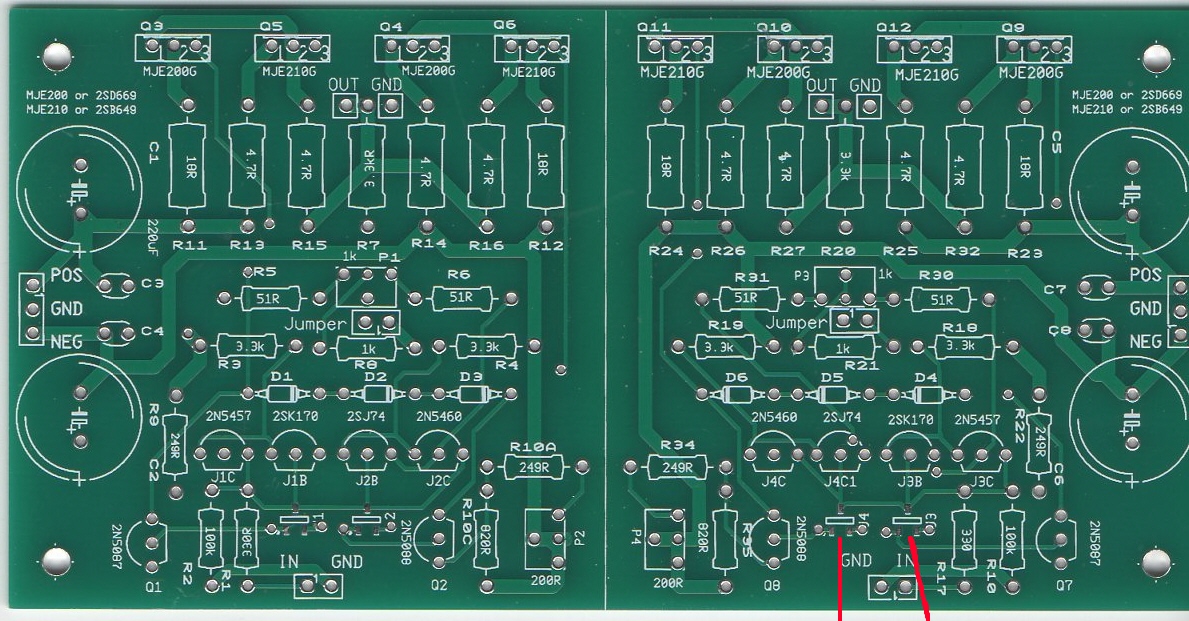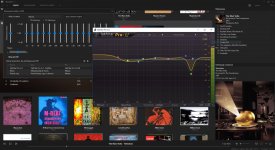As Jack's site is down anyone else here have few spare boards and matched transistors to sell?
Just send him an email, he's having website trouble, but can probably take care of you. (sales@tech-diy.com)
When the original article came out on this sophisticated yet "simple" design in LInear Audio magazine (April 2012 - Vol 3) , there have been many web sites exploring the idea presented on how to auto-EQ a headphone. I am somewhat surprised that such auto-EQ has not taken off here at DIYAudio.
Two years after the concept was shown at least one major manufacturer of headphones has put the concept into its top-of-the-line headphone in 2015. AKG N90Q ($1500).
Has anyone here tried it? It works great, BTW.
THx-RNMarsh
Two years after the concept was shown at least one major manufacturer of headphones has put the concept into its top-of-the-line headphone in 2015. AKG N90Q ($1500).
Has anyone here tried it? It works great, BTW.
THx-RNMarsh
I haven't tried the AKGs nor Auto-EQ, seems to be too much money for the software. I did build a DOA version of the SeNNator which is is fixed eq for Sennheiser HD650s. It's made a lot of difference in the sound of the headphones to get rid of the 150Hz hump along with other issues.
I haven't written it up yet and will probably just put it in the blog section as it's very specific to HD600 and HD650 headphones, plus using a couple of DOAs per channel seems to turn off lots of diyers. The core of the design comes from - diyaudioheaven and the author is solderdude.
EQing headphones makes more difference than any specific headphone amp. Doing it without software requires filters which complicates hardware design.
I haven't written it up yet and will probably just put it in the blog section as it's very specific to HD600 and HD650 headphones, plus using a couple of DOAs per channel seems to turn off lots of diyers. The core of the design comes from - diyaudioheaven and the author is solderdude.
EQing headphones makes more difference than any specific headphone amp. Doing it without software requires filters which complicates hardware design.
I just purchased the article from Linear Audio and had a question: will this amp work on a desktop for small nearfield speakers? I'm thinking of using two TC9FD18 per channel so that would mean 16 ohms, no crossovers, maybe some DSP processing in front of the amplification.
When the original article came out on this sophisticated yet "simple" design in LInear Audio magazine (April 2012 - Vol 3) , there have been many web sites exploring the idea presented on how to auto-EQ a headphone. I am somewhat surprised that such auto-EQ has not taken off here at DIYAudio.
Two years after the concept was shown at least one major manufacturer of headphones has put the concept into its top-of-the-line headphone in 2015. AKG N90Q ($1500).
Has anyone here tried it? It works great, BTW.
THx-RNMarsh
I think these guys caught on to it:
https://www.geteven.co/
Jan
Annoyingly my Theta Casablanca IV running Dirac Live can only take 1 Dirac Live profile else I would have a dedicated profile for headphone use. There are ways around it (running DL in the source and switching the CB DL off) but it's a lot of fluffing about and I haven't pursued it yet.
yes, they are on it and nice looking.... only (?) $179 usd.
https://www.geteven.co/products/even-headphones
THx-RNMarsh
Hey guys, regarding Jack's rev2 PCB, what is the jumper below P1/P3? Are those to connect the signal & power ground? Is there benefit to short it or leave it bare?


Those red lines are a bit misleading 😉 If you are asking about jumpers under P1/P3 then yes - they are used for connecting signal and power ground.
Those are for surface mount devices if you can't get the legged ones!
Those red lines are a bit misleading 😉 If you are asking about jumpers under P1/P3 then yes - they are used for connecting signal and power ground.
Sorry or the confusion guys, I reused miklos' photo. 😀
Thanks for the verification on the signal/power ground connection.🙂
Here is my build - Richard Marsh Headphone Amplifier by BamboszeK - Album on Imgur
The amplifier sounds amazing. Clear, natural tone, deep and tightly controlled bass with great soundstage. Mr. Marsh did very good job with this design. The power supply is based at two TL1963A low noise regulators running at +15V / -15V. Due using same polarity LDOs in floating configuration difference between rails is marginal - like 5-10mV. This paired with 0.1% 15ppm resistors, tightly matched transistors and carefully set trimpots results in vanishingly low DC offset and distortion.
I would aslo like to thanks Jack for providing nice boards and tightly matched transistors in good price.
Measured output impedance at 1kHz is about 0.9Ω if i'm right. With some luck, soon I would be able to perform more measurements with proper gear. I'm especially interested in maximum output power.
The amplifier sounds amazing. Clear, natural tone, deep and tightly controlled bass with great soundstage. Mr. Marsh did very good job with this design. The power supply is based at two TL1963A low noise regulators running at +15V / -15V. Due using same polarity LDOs in floating configuration difference between rails is marginal - like 5-10mV. This paired with 0.1% 15ppm resistors, tightly matched transistors and carefully set trimpots results in vanishingly low DC offset and distortion.
I would aslo like to thanks Jack for providing nice boards and tightly matched transistors in good price.
Measured output impedance at 1kHz is about 0.9Ω if i'm right. With some luck, soon I would be able to perform more measurements with proper gear. I'm especially interested in maximum output power.
Member
Joined 2009
Paid Member
I am somewhat surprised that such auto-EQ has not taken off here at DIYAudio.
I'm interested to learn more, can you point me to a description - maybe a dedicated thread on the topic would be goog?
Well, that's the problem... doesn't seem to be anything here at DIYAudio. But, I did come across other forums else-where who were doing it and then some commercial models being made . I didn't keep notes... so you have to Google for it, yourself. But if others over here want to try it, I would help.
The description of working auto-EQ model was included in Linear Audio magazine's of my headphone amp article.
THx-Richard
The description of working auto-EQ model was included in Linear Audio magazine's of my headphone amp article.
THx-Richard
Not actually Auto-EQ with mic but I'm using headphone equalisation based on measurments. Sites like goldenears.net, innerfidelity.com, superbestaudiofriends.org or graphs.headphone.com publishes accurate measurments of lots popular headphones. By using these graphs and some personal tuning I can achieve pretty nice results. I'm using Beyerdynamics DT990 Pro, my EQ curve looks like in attached photo. My main goal was smoothing out treble peak and adding a bit of "oomph" to lowest sub bass area. Midrange also had some small tweaks. Instead of standalone EQ unit I'm using computer with MusicBee or foobar200 player with VST wrapper plugin.
For everyone interested in that matter I can recommend that reading:
Accudio? - How we make optimized settings. - iPhone app with ready presets
https://diyaudioheaven.wordpress.com/headphones/kameleon/ - headphone amplfier with interchangable EQ modules (lots of general tips about making filters in PDF docs)
For everyone interested in that matter I can recommend that reading:
Accudio? - How we make optimized settings. - iPhone app with ready presets
https://diyaudioheaven.wordpress.com/headphones/kameleon/ - headphone amplfier with interchangable EQ modules (lots of general tips about making filters in PDF docs)
Attachments
Last edited:
Yes but as far as I can see, they do NOT customise/eq the sound depending on your personal hearing characteristics. So that is not the same as what Richard did and what the EarPrint guys do.
Jan
Jan
- Home
- Amplifiers
- Headphone Systems
- Marsh headphone amp from Linear Audio
